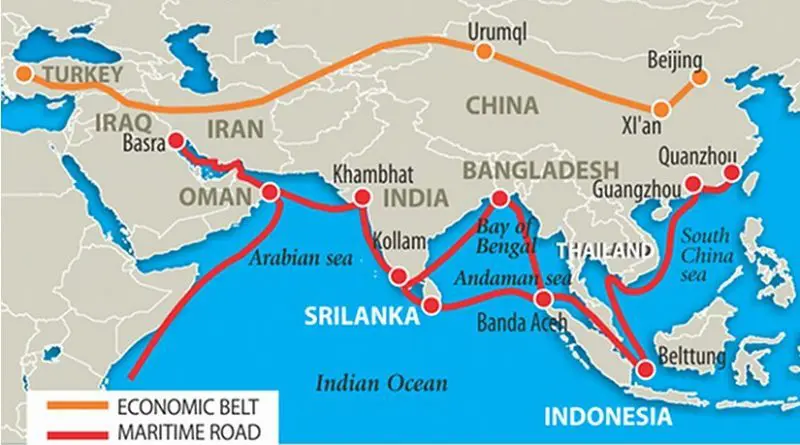What Does China’s Changing Belt And Road Initiative Mean For Central Asian Economies? – Analysis
By Joel Ruet*
With leaders planning their routes to post-Covid-19 recovery, all countries are weighing up the measures needed to return to stability and growth.
In the US, Biden’s $1.9 trillion relief plan has placed stimulus front and centre.
When it comes to China, many eyes have been on the Belt and Road Initiative (BRI), the country’s vast global infrastructure strategy launched in 2013.
For those in the West who view BRI as hostile and expansionist, designed to entrap neighbouring countries in debt, any slowdown of the initiative is a welcome development.
Countries which looked set to benefit from investment will be hoping that BRI continues at pace.
What is clear is that the BRI did not escape Covid-19. In June last year, Wang Xiaolong, a senior official of the Foreign Affairs Ministry, warned that 20% of all BRI projects had been “seriously affected” by Covid-19, while a further 30-40% had also been “negatively affected”.
By December 2020, the FT was reporting that it had not taken long for the “wheels to come off” the BRI initiative, after research showed lending by the China Development Bank and the Export-Import Bank of China collapsed from a peak of $75bn in 2016 to just $4bn last year.
The picture emerging from Beijing is that the BRI after the pandemic will go ahead but will look different. Greater green investment is a clear priority. Investment in fossil fuels, in particular, looks set to drop. The projects most severely disrupted by Covid-19 may well be stopped completely.
In Central Asia, the BRI, which aims to create a new rail network bridging Europe, Central Asia and China, promised to deliver a much-needed infrastructure upgrade to the region.
Former Soviet Union republics of Kazakhstan, Uzbekistan, Kyrgyzstan, Tajikistan and Turkmenistan were mostly reliant on Russia since their independence in the 1990s.
To different extents they remain dependent on Russia economically and politically. Remittances from Central Asian migrant workers in Russia account for up to 30 per cent of GDP in some countries. The railroads still point towards Moscow, hindering internal trade within Central Asia.
However, in recent years Moscow has had little of value to offer struggling Central Asian economies when it comes to investment or longer-term strategic vision, making China’s BRI central to the region’s economic future.
Central Asia will therefore be pleased to note that infrastructure projects look to be largely unscathed by the Covid-19 pandemic. If anything, infrastructure development is back on the agenda as other nations seek to replicate the BRI.
Just last month [April 2021] it was announced that the EU and India are in talks to build joint infrastructure projects around the world in a bid to offer an alternative to China’s projects.
In Central Asia, the current economic outlook is bleak. The World Bank has reported that 2020 saw Central Asia experience its first recession since transitioning from the Soviet system in the mid-1990s.
The slow rollout of vaccines has hindered the path to recovery, and low capacity for vaccine distribution means widespread vaccinations across populations are not expected until 2023, according to the IMF.
A fall in gas prices last year hasn’t helped the region, which has in the past been able to rely on its rich natural resources – particularly oil in Kazakhstan and gas in Turkmenistan.
Signs that China’s economy is returning to business as usual could not have come soon enough: in February, China’s exports grew at a record 154.9% from a year earlier, while imports also grew 17.3%, the most since October 2018.
After a scare, the development of vital new infrastructure links providing greater interconnectivity within Central Asia and between its neighbours looks set to continue at pace.
This will provide a vital lifeline and enormous opportunity for Central Asia, where trade remains the largest sector in terms of GDP and employment structure.
Located on the original route of the Silk Road, which the planned BRI links loosely follow, global trade has been at the heart of Central Asia’s economy and culture for hundreds of years. Large parts of population still mostly make their living on trade.
The largest employer and taxpayer in Kyrgyzstan is Dordoi market. Set up by Askar Salymbekov in 1991 it quickly developed into the largest market in Central Asia covering an area of more than a million square metres.
Dordoi has over 40,000 retail points and employs over 55,000 people. A key transit point for goods coming from China into Russia and Europe, Dordoi looks certain to gain from the BRI and China’s greater focus on trade.
Abu Saxiy market in Uzbekistan, founded in 2006 by Timur Tillyaev on the outskirts of the capital, Tashkent, followed a similar trajectory to Dordoi. In just 15 years, it has become one of the nation’s largest markets and trade logistical companies, with close to 3,000 retail points on an area of over 167,000 square metres. The market is still central to Uzbekistan’s economy. Around 10,000 people shop there every day and it employs over 5,000 people.
Similar markets accounting for large shares of countries’GDP and providing employment for many exist in across all Central Asian states.
With Covid-19 and widespread lockdowns, these markets’ saw profits plummet and business stall. But with the worst of the pandemic apparently over, the resumption of infrastructure development may well be Central Asia’s saving grace.
*Joel Ruet is an economist specialising in emerging economies, from China and India to Africa. He is also the President of a Paris-based think tank, member of the T20 (G20’s engagement group with think tanks), called The Bridge Tank (www.thebridgetank.org)

